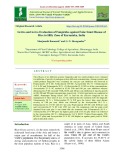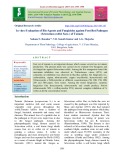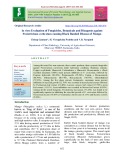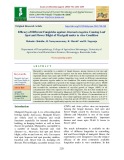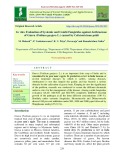
Combi product fungicides
-
The efficacy of six different systemic fungicides and two combi-products were evaluated for inhibition of growth of pathogen at three different concentrations. Among systemic and combi-products fungicides were evaluated, the cent per cent inhibition was observed in Propiconazole 25 % EC, Tebuconazole 250 EC, Azoxystrobin 18.2 % + Difenconazole 11.4 % SC and Tebuconazole 50 % + Trifloxystrobin 25 % WG at all the concentrations.
 12p
12p  trinhthamhodang9
trinhthamhodang9
 16-12-2020
16-12-2020
 17
17
 2
2
 Download
Download
-
In vitro screening of different contact, systemic and combi-products against Alternaria tenuissima the fungus causing leaf blight of kodo millet was done employing poison food technique. The results revealed that, among the four contact fungicides, mancozeb at 0.15 and 0.20 per cent concentration gave the maximum inhibition (69.33 and 66.67%) of mycelial growth.
 6p
6p  angicungduoc8
angicungduoc8
 07-11-2020
07-11-2020
 16
16
 1
1
 Download
Download
-
An in vitro bioassay was undertaken to record the compatibility of local isolate of Trichoderma harzianum with fungicides used in coorg mandarin-pepper-coffee plantations. Eight non-systemic, 10 systemic and 9 combi products fungicides were evaluated against Trichoderma for radial growth inhibition on PDA medium using poisoned food technique. Contact fungicides at selected concentration were found to be safer than systemic and combi products except Chlorothalonil.
 9p
9p  nguathienthan8
nguathienthan8
 20-10-2020
20-10-2020
 14
14
 2
2
 Download
Download
-
Evaluation of new different fungicides, using the susceptible maize genotype CM-202 for the management of turcicum leaf blight caused by Exserohilum turcicum revealed that the combi products Azoxystrobin 18.2% + Difenoconazole 11.4% SC @ 0.250 ml /liter was found more effective in reducing the severity of disease followed by Azoxystrobin 18.2% + Difenoconazole 11.4%) SC @ 0.125 ml /liter were found effective in reducing the disease severity and also contributed for higher grain yield and The treatment which received a foliar spray of systemic fungicide Tebuconazole 250 EC @ 1.
 5p
5p  angicungduoc6
angicungduoc6
 22-07-2020
22-07-2020
 9
9
 1
1
 Download
Download
-
Foot rot of tomato is an important disease which causes severe loss in tomato production. The present study was carried out to evaluate five bioagents and six fungicides against Sclerotium rolfsii. Among the five antagonists tested the maximum inhibition was observed in Trichoderma virens (67%) and contrarily, no inhibition was observed in Bacillus subtilis. Six fungicides viz., carbendazim, captan, tebuconozole, copper oxychloride, hexaconozole and Tebuconazole +Trifloxytrobin at different concentrations (50, 100, 150, 200, 250 and 500 ppm), were tested.
 8p
8p  chauchaungayxua6
chauchaungayxua6
 26-06-2020
26-06-2020
 16
16
 2
2
 Download
Download
-
Among the tested five non-systemic, three combi- products, three systemic fungicides against Peziotrichum corticolum under laboratory condition, Bordeaux mixture, Copper oxychloride, Mancozeb, Carbendazim + Mancozeb, Hexaconazole + Zineb recorded maximum (100%) mean percent inhibition of P. corticolum, followed by Cuprous hydroxide (96.39%), Propiconazole (95.56%), Captan + Hexaconazole (86.39%), Difenconazole (80.74%), Hexaconazole (74.07%), Chlorothalonil (73.92%). Among the five plant extracts (botanicals), maximum mean percent inhibition of mycelial growth (22.
 10p
10p  chauchaungayxua6
chauchaungayxua6
 26-06-2020
26-06-2020
 18
18
 1
1
 Download
Download
-
Marigold is susceptible to a number of fungal diseases, among Alternaria leaf spot and flower blight caused by Alternaria tagetica was the most destructive and economically important disease may cause upto 50-60 % yield losses. In this experiment seven different systemic, contact and combi product fungicides were tested in different concentrations against Alternaria tagetica under in vitro condition. The results revealed that, among the fungicide tested, inhibition of growth of the fungus ranged from 61.81 per cent to 100.00 per cent.
 5p
5p  chauchaungayxua5
chauchaungayxua5
 08-05-2020
08-05-2020
 12
12
 1
1
 Download
Download
-
In recent years Macrophomina phaseolina causing stem canker of pigeonpea is more problematic in pigeonpea growing parts of Karnataka. Present investigation was taken on evaluation of non-systemic, systemic fungicides and bio-agents against M. phaseolina under laboratory condition. Five non systemic, four non systemic and three combi products were evaluated. Similarly two isolates of Trichoderma spp. four Pseudomonas fluorescens isolates, one Pseudomonas putida and one Bacillus subtilis were evaluated against M. phaseolina by poison food technique and dual culture method respectively.
 9p
9p  trinhthamhodang4
trinhthamhodang4
 22-03-2020
22-03-2020
 31
31
 2
2
 Download
Download
-
Guava (Psidium guajava L.) is an important fruit crop of India and is considered to be poor men’s apple. Its production is low in India because of several important diseases by which it suffers. Among diseases, Anthracnose is one that impairs the quality and has become a serious obstacle for the cultivation of guava fruits. Keeping in view the significance of the problem, research was conducted to screen the different chemicals under in vitro for the management of the disease.
 6p
6p  chauchaungayxua4
chauchaungayxua4
 18-03-2020
18-03-2020
 24
24
 3
3
 Download
Download
-
Rice (Oryza sativa L.) is an important cereal crop belonging to the grass family Poaceae. An experiment was conducted during Kharif 2017 and 2018 to know the impact of nine fungicide treatments. Among nine treatments, Azoxystrobin 18.2 % w/w +Difenoconazole 11.4% w/w SC @ 1.0 g/L and Trifloxystrobin 25% + Tebuconazole 50% WG @ 0.4 g/L were on par with each other with least pooled leaf blast disease index of 20.03% and 20.90% and neck blast disease incidence of 16.48% and 16.93% respectively followed by Tricyclazole 75% WP @ 0.6 g/L.
 7p
7p  trinhthamhodang3
trinhthamhodang3
 22-02-2020
22-02-2020
 9
9
 1
1
 Download
Download
CHỦ ĐỀ BẠN MUỐN TÌM








